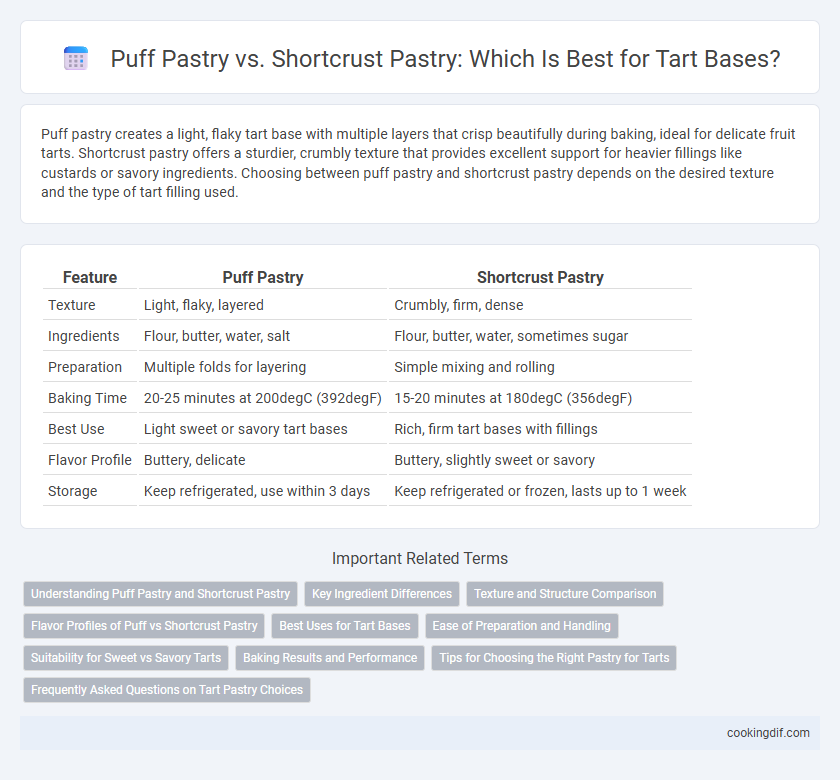Puff pastry creates a light, flaky tart base with multiple layers that crisp beautifully during baking, ideal for delicate fruit tarts. Shortcrust pastry offers a sturdier, crumbly texture that provides excellent support for heavier fillings like custards or savory ingredients. Choosing between puff pastry and shortcrust pastry depends on the desired texture and the type of tart filling used.
Table of Comparison
| Feature | Puff Pastry | Shortcrust Pastry |
|---|---|---|
| Texture | Light, flaky, layered | Crumbly, firm, dense |
| Ingredients | Flour, butter, water, salt | Flour, butter, water, sometimes sugar |
| Preparation | Multiple folds for layering | Simple mixing and rolling |
| Baking Time | 20-25 minutes at 200degC (392degF) | 15-20 minutes at 180degC (356degF) |
| Best Use | Light sweet or savory tart bases | Rich, firm tart bases with fillings |
| Flavor Profile | Buttery, delicate | Buttery, slightly sweet or savory |
| Storage | Keep refrigerated, use within 3 days | Keep refrigerated or frozen, lasts up to 1 week |
Understanding Puff Pastry and Shortcrust Pastry
Puff pastry consists of multiple thin layers of dough and butter, creating a flaky, airy texture when baked, ideal for delicate, crisp tart bases that rise and separate. Shortcrust pastry is denser and crumbly, made from a mixture of flour, butter, and minimal water, providing a sturdy and buttery foundation suitable for both sweet and savory tarts. Understanding the structural differences helps bakers choose puff pastry for light, layered tart shells and shortcrust for rich, firm tart bases.
Key Ingredient Differences
Puff pastry relies heavily on butter as a key ingredient, creating multiple flaky, airy layers through repeated folding and rolling, while shortcrust pastry uses a higher proportion of flour to fat, usually butter or shortening, resulting in a denser, crumbly texture. The moisture content in puff pastry dough is crucial for steam generation, causing the dough to rise and separate into layers, contrasting with shortcrust pastry's uniform, compact structure formed by minimal water and gentle mixing. Understanding these ingredient-driven differences helps bakers select the ideal tart base, balancing texture and flavor to suit sweet or savory fillings.
Texture and Structure Comparison
Puff pastry offers a light, flaky texture with multiple crisp layers created by folding butter into dough, ideal for a delicate tart base that provides a contrast to rich fillings. Shortcrust pastry delivers a crumbly, tender structure with a denser, buttery consistency, offering sturdy support and a melt-in-the-mouth experience perfect for more robust, creamy tarts. The choice between puff pastry and shortcrust pastry largely depends on whether a crisp, airy texture or a firm, crumbly foundation better complements the tart's flavor and presentation.
Flavor Profiles of Puff vs Shortcrust Pastry
Puff pastry delivers a light, flaky texture with buttery richness and delicate air pockets that enhance both sweet and savory tarts. Shortcrust pastry offers a crumbly, sturdy base with a buttery, slightly sweet flavor that provides a contrastingly hearty bite. The choice between puff and shortcrust pastry influences the tart's flavor profile by balancing crispness and texture complexity.
Best Uses for Tart Bases
Puff pastry offers a light, flaky texture ideal for fruit tarts and delicate dessert bases that require crisp layers. Shortcrust pastry provides a sturdy, crumbly foundation suited for savory tarts and rich custard fillings, holding shape well during baking. Choosing between puff pastry and shortcrust depends on desired tart texture and filling compatibility.
Ease of Preparation and Handling
Puff pastry requires precise temperature control and multiple folding steps, making it more challenging and time-consuming to prepare and handle compared to shortcrust pastry. Shortcrust pastry offers greater ease of preparation with a simple mix-and-chill process, providing a sturdy, crumbly texture that holds tart fillings well. For bakers seeking convenience and straightforward handling, shortcrust pastry is often preferred over puff pastry for tart bases.
Suitability for Sweet vs Savory Tarts
Puff pastry's flaky, buttery layers make it ideal for both sweet and savory tart bases, providing a light, crisp texture that complements fruit fillings and rich cheese or vegetable mixes. Shortcrust pastry offers a sturdier, crumbly texture better suited for sweet tarts with delicate custards or jams and savory tarts requiring a firm foundation for heavier ingredients like quiches or meat fillings. The choice depends on the desired texture and robustness needed to support the tart's filling while enhancing overall flavor.
Baking Results and Performance
Puff pastry delivers a light, flaky texture with multiple airy layers that rise significantly during baking, making tart bases crisp and delicate. Shortcrust pastry offers a dense, crumbly, and buttery crust that provides structural stability, ideal for holding moist or heavy fillings without becoming soggy. Baking performance varies as puff pastry requires precise temperature control for optimal puffing, while shortcrust pastry benefits from thorough chilling to prevent shrinkage and ensure even browning.
Tips for Choosing the Right Pastry for Tarts
Choose puff pastry for tart bases when seeking a light, flaky texture that provides a dramatic, layered crust ideal for fruit or savory fillings requiring a crisp contrast. Opt for shortcrust pastry for a sturdier, crumbly base that offers a rich, buttery flavor and excellent structural support, perfect for custard or cream-filled tarts. Consider baking time and filling moisture content; puff pastry handles wet fillings well by creating a barrier, while shortcrust ensures stability and prevents sogginess in dense or wet toppings.
Frequently Asked Questions on Tart Pastry Choices
Puff pastry is favored for tart bases that require a light, flaky texture, offering multiple buttery layers that rise during baking. Shortcrust pastry provides a tender, crumbly foundation ideal for both sweet and savory tarts, with a denser consistency that holds fillings well. Common questions about tart pastry choices often focus on texture preferences, baking techniques, and the best pastry for specific tart fillings.
Puff pastry vs shortcrust pastry for tart bases Infographic

 cookingdif.com
cookingdif.com